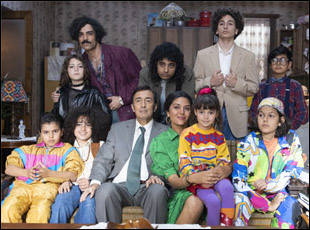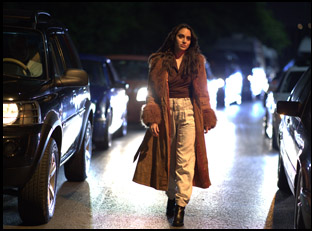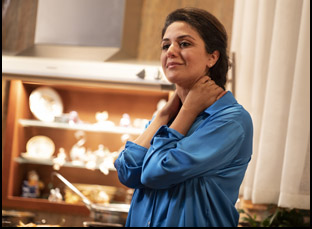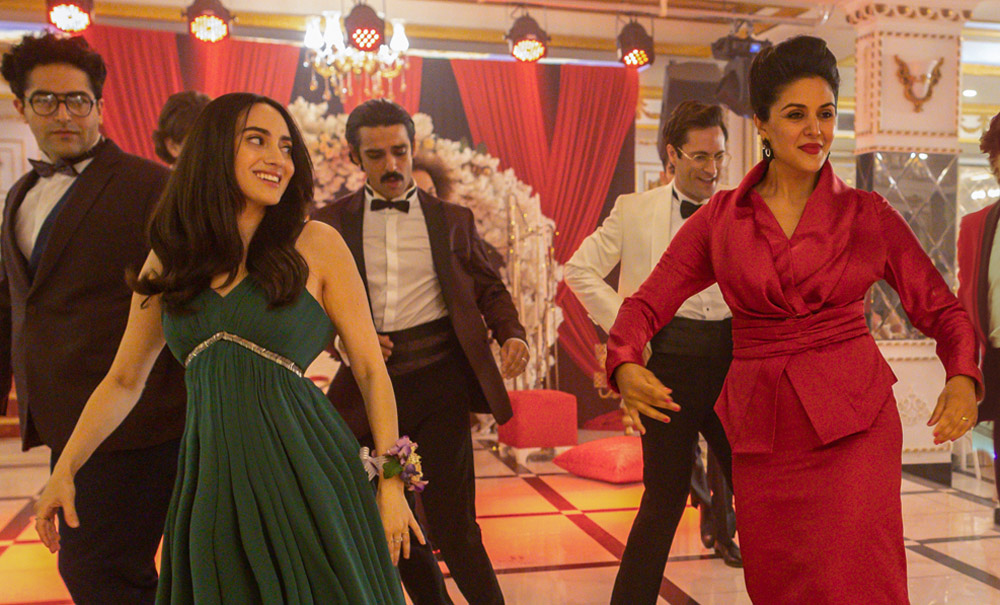If Maryam Keshavarz ever had any doubts whether telling the story of her family who had moved from Iran to America when her father, a doctor, was sought out for his medical expertise, in her latest film “The Persian Version” would play well beyond the community she grew up around, she only needed to look at the crew around her working on it to know she was onto something far bigger.
“We knew it was something special that hadn’t been done,” says Keshavarz, who would win the Audience Award at Sundance for her first comedy. “I think everyone who was involved was very dedicated because they knew it was my story, but also because it was their story. It was a story of biculturalism. There are Iranians from the UK, from the Netherlands, from Canada and the U.S. and I thought it was so beautiful when we would rehearse and people would bring their own stories to the forefront. Even to this day, I have a Whatsapp group from my actual family and then I have a Whatsapp group from my film family and they’re equally difficult to get people to be there on time for lunch.”
Keshavarz has made appointment viewing with her undeniably entertaining third feature, playfully recounting her personal experience of becoming a mother and realizing the sacrifices that the women in her family had to make to give her the life she has. The writer/director plays fast and loose with the facts — billed as a “true story, sort of…” the craziest parts of the film are the most autobiographical when on a break from a lesbian relationship, the filmmaker’s onscreen surrogate Leila (Layla Mohammadi) ends up carrying a child from a spur-of-the-moment one-night stand, confusing her conservative mother Shireen (Niousha Noor) who already had a hard time accepting her same-sex relationships. But “The Persian Version” is sly in so many other ways when Keshavarz recognizes that everyone has their own personal truth and beyond giving her characters the power to freeze time to explain themselves, they can see in one another what they might be too distracted to notice from their own perspective as Leila describes her angst in wanting to be accepted in her mother’s eyes, but Shireen is envisioned her own battle for acceptance, having to make ends meet for Leila and her eight brothers when her husband requires a heart transplant and she gets her real estate license, cleverly engineering a steady business securing property for underserved immigrant communities.
That kind of savviness clearly runs in the family when Keshavarz is able to reconcile so many disparate ideas throughout “The Persian Version,” shuttling back and forth from Iran to America where a desire to push the envelope can get Leila into trouble in both countries but also breeds an ability to break through traditional thinking and such a disregard for rules turns the film into a joyous celebration of both community and individualism as one finds and protects their own voice inside of it, complete with boisterous musical numbers and dazzling verve throughout. With the film bound to turn every theater it plays into a dance hall when it begins its release this weekend, the director of “Circumstance” spoke about how she came to commit this part of her life to the screen, masterminding a cross-continental shoot between New York and Turkey on an indie budget and how music became a way to blend cultures.

It’s always the right time to make fun of yourself. [laughs] It’s my own therapy. Honestly, it is in some ways the culmination of why I even went into cinema. I left academia behind when 9/11 happened to change the image of people from the Middle East because I felt it was grossly misrepresented. And then I made my films and I worked in TV and then when Trump came to power, all the xenophobic rhetoric and the Muslim ban really affected my family, so I thought I really want to make something about being American — Iranian American — but I really want to make it full of joy and to show who we really are. And I thought well who’s more crazy in the Iranian American community than my big family. Who doesn’t who can’t relate to that? We all have families, we all have parents — we might not have kids, but we certainly have parents and siblings, so I thought that might be a good place to start. Then as I started writing I realized it’s the story of the women in our family.
You find a marvelous way to channel multiple perspectives. Was it a challenge to structure?
It really was because I knew I wanted to write about my family and everybody has so many interesting stories. My father, for instance, was a doctor in Bed-Stuy during the AIDS crisis and crack cocaine epidemic and that was an interesting story, [and there were all] my siblings, too. But when I was really trying to understand like why I’m writing the story and who the narrator is, I started understanding that when my mother came to America she rewrote her own history. She started a whole life and when I thought about it, she was my co-writer. When I cracked that, I knew I always knew that Leila will address the camera but I never knew that the mother would address the camera. When I realized that the mother has to take over the story and the narration, I thought “Oh, interesting. So it’s really about these three generations — the mother, the grandmother and her, but the only two people that can break the fourth wall are the mother and daughter because they’re the ones that are at odds with each other.”
Each section I thought would be interesting to have a different style because they’re to portray the characters [of their time] —the daughter is ‘80s/‘90s pop sitcom, the grandmother is [strong and silent, from] a spaghetti western, and their mother is more of a typical Kiarostami neorealist Iranian film. Once I knew these were really just the stories of these three women, it was more about the mother and daughter and all of the other stories faded away. Maybe they’ll be in the TV show version, but the brothers and the men in [general] became the Greek chorus, there just to be a support for the female stories, which you never see actually.
With the direct address, I know how hard it was for Joachim Trier to pull off freezing time in “The Worst Person in the World.” Were some of those scenes difficult in this?
It’s so funny [because] they literally just don’t move, right? It’s not even that magical. The biggest thing about the mother freezing time is the actress is a 14-year-old from Iran. She’s never acted [before] and that’s in a single take with no cuts and it’s a four-page monologue. The fact that she hits it every time was the biggest thing I was scared of, but but then actually when we did it it ended up not being as technically difficult as I anticipated. But it’s so funny that you say Joachim Trier because his first film “Reprise” is such a big influence on how I made this film. I love “Reprise” and how he blends together different film techniques to tell that story. It’s one of those rare films I saw in the cinema three times.

I love musicals.
How early did that become part of the process for you?
When I first was describing the story, a producer had heard it and implored me to write [down] this [part] about how I used to smuggle tapes in my underwear. I thought I’ve always been a kind of a translator of culture, bringing tapes [of American pop music] to Iran and then I would bring tapes back from Iran to America and I would tell Iranians, “Oh, America is not what you think” and I would tell Americans, “Iran’s not what you think.” That’s the heart of this bicultural tension that’s throughout the whole film and I thought music is such a wonderful way to tell that story so there’s both underground music from Iran from the ’60s and there’s ’80s and ’90s American pop music. Of course, we have Cyndi Lauper [and “Girls Just Want to Have Fun”] which is for me was the song growing up and thematically, this film is about three generations of women that push the status quo, so we realized that we had to remake that song as a Persian version and Rostam [Batmanglij, our composer] was the perfect guy. I love how in Vampire Weekend, he mixes East and West in the music of that group and the score is really a mix of both cultures. Sometimes it’s unexpected [where] you’ll have like an American song in the Iran section or you have an Iranian song in an American section, and it’s a way for me to weave together the interconnectedness subconsciously for you of the two cultures.
What’s it like to set up a cross-continental shoot like this?
I’ve always worked in crazy areas. My first short was shot in Argentina and I’m not Argentinian, and I shot “The Color of Love” in Iran, but then I shot “Circumstance” in Lebanon standing in for Iran even though I had never been to Lebanon. Then I shot a film in New York and then a film in Turkey, so I’ve always done that in some way and I guess I am acclimated to going to places where I don’t know anything and figuring it out. I have a background in producing photo shoots before I went into film and I’m just always looking for the perfect location. I don’t care where it is. And once I decided it would be Turkey as our partner, I went there well ahead of time and our production company created relationships with Diloy Gülün, who’s a big producer in Turkey. All the Turkish crew were so invested because they felt that bicultural identity themselves as people who have a lot of their family emigrated to the West, so there were a lot of people that were dedicated to the film. I was really fortunate and cognizant to have enough time to develop those relationships because I had a bad experience on a previous film that I really hire people that are the best of their jobs, but that are dedicated for a reason besides the paycheck.

I love her, and I’m so fortunate she’s an actress. She came here to America when she was 13 and she’s been struggling for so long, but she continued to hone her craft and do music classes and do dance classes and waiting for the day that she got her shot and [here she is] at 40 and she’s got the biggest shot of her career. She was so dedicated to the film and [for the wedding dance], this family has a line dance [because] they’re so close and she spent so much time with the other actors during their days off to do it. Then she showed it to me and I loved it. She was just so much about creating that unity through dance.
The funniest thing is that when we wrapped the film, we were doing the music and we knew we wanted a Persian version of “Girls Just Want to Have Fun” and I called [her] and said, “Hey, I don’t want an American singer to the Persian version of this. Do you know any Iranian American singers?” And she says, “Maryam, don’t you remember how you met me at a Persian New Year’s party many years ago [where I was] singing?” And she’s not only sings, but she plays several instruments. She’s a triple threat and I’m so glad people will get to know her because she is truly an amazing talent. She plays 30 years of a character and she really pulls off becoming a mother so well — something about how she carries her body. My mother was like, “Oh my God, she really got me.”
I hear she approves of the film. In general, what’s it like having this out in the world?
Having people connect with it from all different backgrounds and really seeing that that really was one of my big reasons of making it. [I wanted] people to feel like, “Oh, I know this family” and having people laugh and cry at the end. Certainly people from our culture are blown away when they watch it, but also other immigrants. I had an Irish guy who said it’s like his family or a Chinese immigrant who felt like it was so similar to their family. Those immigrant stories are what I’ve always connected with and you long to see yourself in those, and a lot of people have said, “I called my mom after” or “someone in my family that I haven’t talked to in a while” and that was another part of it. I wanted people to feel like we don’t have to all have the exact point of view to love each other.
“The Persian Version” opens on October 20th in Los Angeles and New York before expanding across the country on October 27th. A full list of theaters and dates is here.




